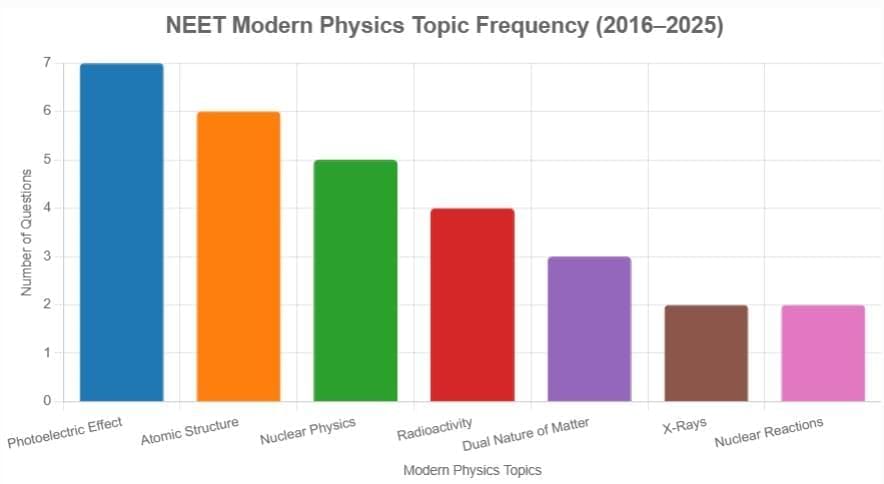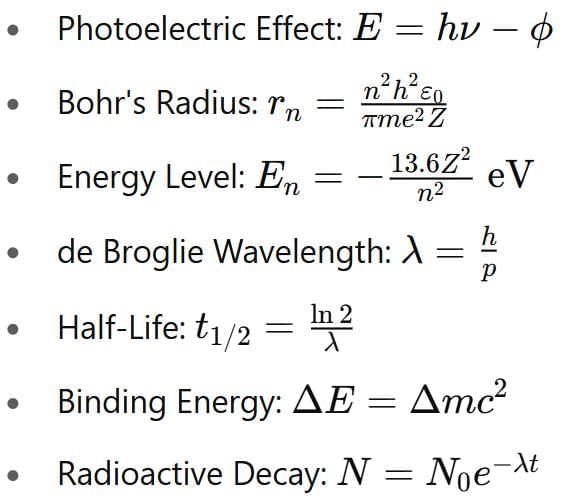How to Study Modern Physics for NEET | Physics Class 12 PDF Download
Introduction
Modern Physics is a high-scoring and concept-rich unit in NEET, contributing 4–6 questions every year. It covers key topics like the Photoelectric Effect, Atomic Structure, and Nuclear Physics. This guide simplifies your preparation with a focus on high-weightage areas, smart problem-solving, and exam-ready strategies, so you master the chapter quickly and effectively.

Understanding NEET Modern Physics Syllabus
To start strong, it’s important to know what to study. Here’s a list of topics commonly asked in NEET
Photoelectric Effect
Atomic Structure
Nuclear Physics
Radioactivity
Dual Nature of Matter
X-Rays
Nuclear Reactions
Bohr's Model
de Broglie Hypothesis
Quantum Mechanics Basics
Focus on Core Concepts
Knowing which topics matter most can supercharge your revision. Based on the 2016 - Present NEET analysis, here’s the topic-wise breakdown of all the core concepts that we should focus on

Photoelectric Effect (7 questions): Einstein's equation and threshold frequency.
Atomic Structure (6 questions): Bohr's model and energy levels.
Nuclear Physics (5 questions): Nuclear binding energy and mass defect.
Radioactivity (4 questions): Decay laws and half-life.
Dual Nature of Matter (3 questions): de Broglie wavelength and wave-particle duality.
X-Rays (2 questions): Production and properties.
Nuclear Reactions (2 questions): Fission and fusion processes.
How to Study Important Topics
Once you know what to study, it’s time to understand how to study each topic.
Here's how to approach them smartly
Photoelectric Effect
Focus: Master Einstein's equation (E = hν - φ) and threshold frequency; understand the photoelectric equation, often tested with work function problems.
Method: Solve 10–15 problems daily on photon energy, derive the equation, and analyze stopping potential scenarios.
Atomic Structure
Focus: Grasp Bohr's model and energy levels (En = -13.6Z²/n² eV); frequently tested with Bohr's postulates and spectral lines.
Method: Practice 5–10 problems daily on radius and energy calculations, derive rn, and study the hydrogen spectrum.
Nuclear Physics
Focus: Understand nuclear binding energy (ΔE = Δmc²) and mass defect; often tested with nuclear stability concepts.
Method: Solve 5–10 problems daily on binding energy, calculate mass defect, and analyze nuclear stability.
Radioactivity
Focus: Learn decay laws (N = N₀e⁻λt) and half-life (t₁/₂ = ln(2)/λ); commonly tested with radioactive decay series.
Method: Practice 5–10 problems daily on half-life and activity, derive decay equations, and study decay constants.
Resources for Important Topics
Core Materials: NCERT Physics Class 12 (Chapter 11: Dual Nature of Radiation and Matter, Chapter 12: Atoms, Chapter 13: Nuclei), HC Verma's Concepts of Physics (Modern Physics), DC Pandey's Objective Physics for NEET.
Supplementary Resource: EduRev app (EduRev) for video lectures, practice questions, and mock tests tailored to NEET preparation.
Memorize and Understand Formulas
Having a strong grip on formulas saves time and boosts accuracy. Memorize the following and practice their application
Essential Formulas

Learning Approach
Develop a formula sheet and derive equations (e.g., Bohr's model) to deepen understanding.
Use flashcards for quick recall.
Apply formulas in numerical problems to reinforce concepts and avoid rote learning.
Consistent Numerical Practice
By the time you finish each concept, regular practice will make the numericals easier. Here’s how to keep it consistent
- Daily Objective: Solve 20–30 numerical problems daily, prioritizing high-frequency topics: Photoelectric Effect, Atomic Structure, Nuclear Physics, and Radioactivity.
- Problem Sources: DC Pandey's Objective Physics, past NEET question papers, and EduRev app question banks.
- Focus Areas: Photoelectric effect calculations, atomic energy levels, nuclear binding energy, and radioactivity decay problems.
- Strategy: Time practice sessions to 1–2 minutes per question and maintain an error log to address recurring mistakes.
Analysis of Previous Years Papers
Understanding past trends helps predict future questions. Key patterns
- Purpose: Identify patterns and difficulty levels in Modern Physics questions.
- Scope: Review NEET Physics papers from 2016–2025, focusing on Photoelectric Effect (e.g., threshold frequency), Atomic Structure (e.g., Bohr model), and Nuclear Physics (e.g., binding energy).
- Expectation: Anticipate 4–6 questions, with a strong likelihood of Photoelectric Effect and Atomic Structure problems.
- Resource: Utilize the EduRev app (EduRev) for past papers.
Mock Test Practice
Testing yourself is just as important as studying.
- Objective: Simulate exam conditions to improve time management and accuracy.
- Goal: Aim for 1–2 minutes per question during timed mock tests.
- Resource: Use the EduRev app (EduRev) for mock tests and analyze performance on high-priority topics.
Exam Day Tips
Quick Formula Review: Before the exam, glance at your formula sheet for Photoelectric Effect, Atomic Structure, and Nuclear Physics to reinforce key equations.
Prioritize High-Weightage Questions: Start with Photoelectric Effect and Atomic Structure questions, as they are more likely to appear and often solvable with clear formulas.
Time Allocation: Spend 1–2 minutes per question; skip complex numericals initially and return if time permits.
Check Units and Calculations: Ensure units are consistent (e.g., eV for energy) and double-check multi-step calculations, especially for Nuclear Physics.
Stay Calm: If stuck on a radioactivity or dual nature problem, take a deep breath and break it into smaller steps (e.g., use the decay law).
Additional Preparation Strategies
Consistency: Maintain a daily commitment of 2 hours to Modern Physics for steady progress.
Precision: Verify calculations in multi-step numericals (e.g., Photoelectric Effect, Nuclear Physics) to minimize errors.
Time Management: Allocate 1–2 minutes per question initially, revisiting complex problems as needed.
Well-being: Prioritize 6–8 hours of sleep, incorporate 5-minute breaks hourly, and maintain a balanced diet to support focus and stamina.
Motivation: Set achievable short-term goals (e.g., mastering Photoelectric Effect) and acknowledge progress to sustain momentum.
This structured guide, grounded in NEET trends and enriched with targeted strategies, is your ultimate roadmap to conquer Modern Physics. Focus on Photoelectric Effect, Atomic Structure, Nuclear Physics, and Radioactivity to maximize your Physics score.
Best wishes for your NEET preparation!
|
74 videos|314 docs|88 tests
|
FAQs on How to Study Modern Physics for NEET - Physics Class 12
| 1. What are the core concepts of Modern Physics that are essential for NEET preparation? |  |
| 2. How can students effectively memorize and understand formulas in Modern Physics? |  |
| 3. What strategies can students use for consistent numerical practice in Modern Physics? |  |
| 4. How important is it to analyze previous years' papers for NEET preparation in Modern Physics? |  |
| 5. What are some effective exam day tips for students taking the NEET in Modern Physics? |  |




















